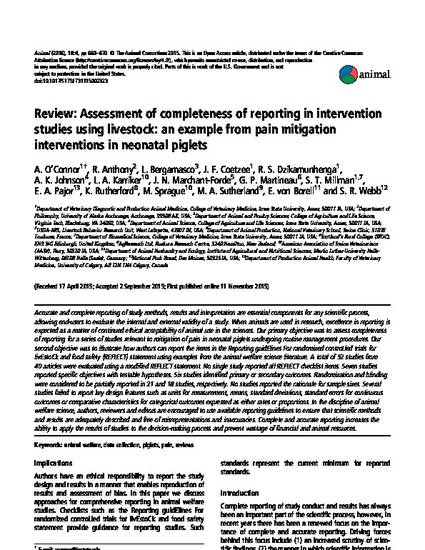
Accurate and complete reporting of study methods, results and interpretation are essential components for any scientific process, allowing end-users to evaluate the internal and external validity of a study. When animals are used in research, excellence in reporting is expected as a matter of continued ethical acceptability of animal use in the sciences. Our primary objective was to assess completeness of reporting for a series of studies relevant to mitigation of pain in neonatal piglets undergoing routine management procedures. Our second objective was to illustrate how authors can report the items in the Reporting guidElines For randomized controLled trials for livEstoCk and food safety (REFLECT) statement using examples from the animal welfare science literature. A total of 52 studies from 40 articles were evaluated using a modified REFLECT statement. No single study reported all REFLECT checklist items. Seven studies reported specific objectives with testable hypotheses. Six studies identified primary or secondary outcomes. Randomization and blinding were considered to be partially reported in 21 and 18 studies, respectively. No studies reported the rationale for sample sizes. Several studies failed to report key design features such as units for measurement, means, standard deviations, standard errors for continuous outcomes or comparative characteristics for categorical outcomes expressed as either rates or proportions. In the discipline of animal welfare science, authors, reviewers and editors are encouraged to use available reporting guidelines to ensure that scientific methods and results are adequately described and free of misrepresentations and inaccuracies. Complete and accurate reporting increases the ability to apply the results of studies to the decision-making process and prevent wastage of financial and animal resources.
Available at: http://works.bepress.com/anna_butters-johnson/288/

This article is published as O’Connor, Annette, Raymond Anthony, Luciana Bergamasco, J. F. Coetzee, R. S. Dzikamunhenga, A. K. Johnson, L. A. Karriker et al. "Assessment of completeness of reporting in intervention studies using livestock: an example from pain mitigation interventions in neonatal piglets." animal 10, no. 4 (2016): 660-670. Doi: 10.1017/S1751731115002323. Posted with permission.